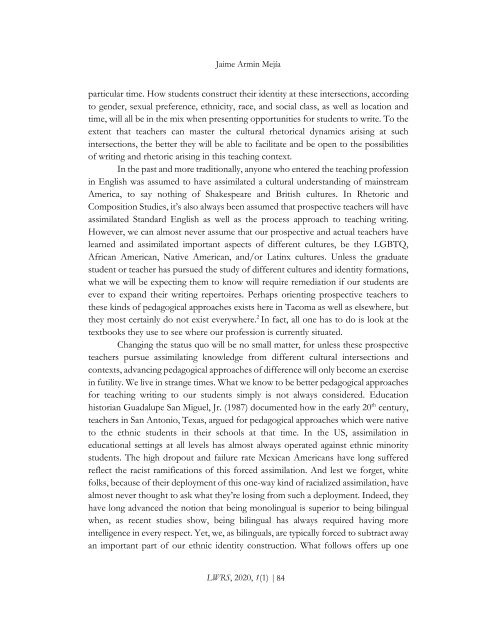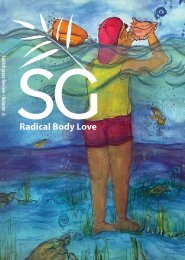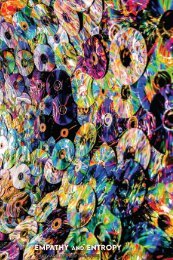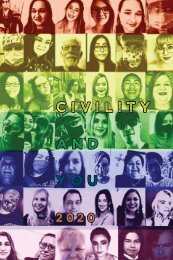LWRS June 2020 Volume 1, Issue 1
Inaugural Issue co-edited by Yndalecio Isaac Hinojosa and Isabel Baca
Inaugural Issue co-edited by Yndalecio Isaac Hinojosa and Isabel Baca
You also want an ePaper? Increase the reach of your titles
YUMPU automatically turns print PDFs into web optimized ePapers that Google loves.
Jaime Armin Mejía<br />
particular time. How students construct their identity at these intersections, according<br />
to gender, sexual preference, ethnicity, race, and social class, as well as location and<br />
time, will all be in the mix when presenting opportunities for students to write. To the<br />
extent that teachers can master the cultural rhetorical dynamics arising at such<br />
intersections, the better they will be able to facilitate and be open to the possibilities<br />
of writing and rhetoric arising in this teaching context.<br />
In the past and more traditionally, anyone who entered the teaching profession<br />
in English was assumed to have assimilated a cultural understanding of mainstream<br />
America, to say nothing of Shakespeare and British cultures. In Rhetoric and<br />
Composition Studies, it’s also always been assumed that prospective teachers will have<br />
assimilated Standard English as well as the process approach to teaching writing.<br />
However, we can almost never assume that our prospective and actual teachers have<br />
learned and assimilated important aspects of different cultures, be they LGBTQ,<br />
African American, Native American, and/or Latinx cultures. Unless the graduate<br />
student or teacher has pursued the study of different cultures and identity formations,<br />
what we will be expecting them to know will require remediation if our students are<br />
ever to expand their writing repertoires. Perhaps orienting prospective teachers to<br />
these kinds of pedagogical approaches exists here in Tacoma as well as elsewhere, but<br />
they most certainly do not exist everywhere. 2 In fact, all one has to do is look at the<br />
textbooks they use to see where our profession is currently situated.<br />
Changing the status quo will be no small matter, for unless these prospective<br />
teachers pursue assimilating knowledge from different cultural intersections and<br />
contexts, advancing pedagogical approaches of difference will only become an exercise<br />
in futility. We live in strange times. What we know to be better pedagogical approaches<br />
for teaching writing to our students simply is not always considered. Education<br />
historian Guadalupe San Miguel, Jr. (1987) documented how in the early 20 th century,<br />
teachers in San Antonio, Texas, argued for pedagogical approaches which were native<br />
to the ethnic students in their schools at that time. In the US, assimilation in<br />
educational settings at all levels has almost always operated against ethnic minority<br />
students. The high dropout and failure rate Mexican Americans have long suffered<br />
reflect the racist ramifications of this forced assimilation. And lest we forget, white<br />
folks, because of their deployment of this one-way kind of racialized assimilation, have<br />
almost never thought to ask what they’re losing from such a deployment. Indeed, they<br />
have long advanced the notion that being monolingual is superior to being bilingual<br />
when, as recent studies show, being bilingual has always required having more<br />
intelligence in every respect. Yet, we, as bilinguals, are typically forced to subtract away<br />
an important part of our ethnic identity construction. What follows offers up one<br />
<strong>LWRS</strong>, <strong>2020</strong>, 1(1) | 84





